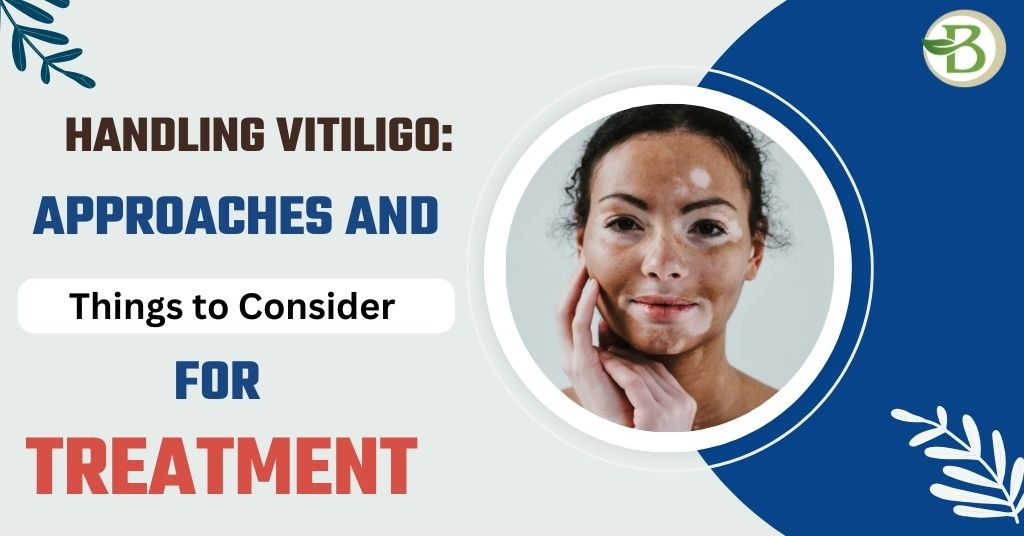Living with vitiligo can sometimes cause feelings of self-consciousness about your skin and its patches, especially in the initial days. People with this medical condition often lack self-acceptance, which leads to low self-image. Without embracing the fact that there are many vitiligo treatment options available and with certain lifestyle modifications, you may gain maximum benefits.
For efficient management of vitiligo, you have to work on four aspects: taking care of your skin, implementing some dietary modifications, managing your stress level, and opting for the most effective treatment procedure. In this blog, we will discuss all these aspects to cure vitiligo in detail. But before we move further, remember every one of us faces difficulties in life. Sometimes it’s visible and obvious, and sometimes it’s not. But the ultimate option we have is to stay strong and deal with them bravely. So, my readers, we all are beautiful the way we are.
Navigating Skin Care with Vitiligo
When navigating skincare with vitiligo, it’s essential to carefully consider preserving overall skin health and preventing areas affected by depigmentation. Strategies such as using gentle skin care products, incorporating protection to protect against sun damage, and seeking advice from skincare professionals familiar with vitiligo can help with white patches on skin treatment. Below, we have mentioned the most basic steps that you may implement on a daily basis.
- Skin protection from Sunlight
It is advisable to wear fully covered clothes and a scarf while going out, especially in the afternoon. Umbrellas serve a purpose beyond protecting from rain. An umbrella or parasol can prevent direct UV rays from reaching your skin.
- Immune your Skin Naturally
Fruits like blueberries and watermelon, leafy greens, nuts, seeds, and vegetables contain essential nutrients that can enhance your skin’s ability to protect itself from the sun. Blueberries and watermelon are rich in antioxidants and vitamins, which can help to strengthen your skin’s natural defences against the sun. Leafy greens, nuts, seeds, and vegetables also provide essential nutrients that support your skin’s ability to protect itself from sun damage.
- Do not go for Tattoos.
Although it might be tempting to conceal a light spot or patch with a tattoo, doing so can lead to issues. Skin damage caused by a tattoo may result in a new patch of vitiligo appearing within two weeks.
Controlling Vitiligo Through Diet & Nutrition
Occasionally, dietary modifications may also aid in the management of this medical condition. Although there are no particular food groups that can treat vitiligo, consuming foods that reduce inflammation may be beneficial. Additionally, some foods have the potential to exacerbate inflammation and make the situation more challenging. So, let’s have a look at what to include and what not to include in your diet from a Vitiligo point of view.
What to include in your diet?
- Omega 3 Fatty Acids
Foods rich in omega-3 fatty acids, like almonds, walnuts, avocados, and fatty fish, form a vital part of the vitiligo diet. Omega-3 fatty acids helps in regulating blood circulation, prevent inflammation, and trigger the immune system.
- Antioxidant-rich foods
Antioxidants are compounds that limit oxidation, a chemical reaction that damages cells in the body. Antioxidant-rich foods help prevent cellular damage and limit inflammation, resulting in vitiligo prevention.
- Whole grains:
Try to limit or avoid including refined grains in your meals, as they usually lack essential nutrients found in whole grains. Consume grains and foods like brown rice, whole-wheat pasta, and oats.
- Stay hydrated
Sufficient water intake is important for overall health, and this is especially true for individuals with vitiligo, as it helps maintain skin health. A well-hydrated skin can reduce the appearance of depigmented patches and promote an even skin tone in individuals with vitiligo.
- Add some healthy fats.
A poor fat source in your everyday diet might significantly exacerbate Vitiligo symptoms. Instead of hydrogenated and processed fats, choose the food wisely. Fats from healthy sources also protect us against inflammation.
What must be avoided?
- Vitamin C rich foods
Vitamin C inhibits melanin synthesis and acts as an inhibitor of skin pigmentation. Foods and Fruits which are rich in vitamin C and ascorbic acid can lead to widening white patches. Lemon, oranges, and grapes are some examples.
- Turmeric:
We Know turmeric as a natural herb with numerous benefits. However, very few people know that curcuminoids, an active component of the spice, cause the discolouration of human skin. So, vitiligo patients must avoid it.
- Cold drinks:
Carbonated and sweetened drinks can reduce metabolism and negatively impact skin health. As it is a skin-related disease, anything that affects the skin will consequently affect the condition.
- Processed foods and Preservatives:
Vitiligo is an autoimmune disease. Highly processed foods and preservatives have a negative impact on our immune system. They are hard to digest and lead to multiple complications in our bodies.
- Dairy Products:
Limited and reasonable consumption of milk and milk products is allowed. However, including too many dairy products is not advisable for a vitiligo patient as milk proteins have a tendency to reduce the re-pigmentation cycle.
Managing the psychological impact of vitiligo
Proper sleep:
To effectively manage stress, it’s crucial to prioritise restful and sufficient sleep. Habits like overthinking and overworrying may create hurdles in it. However, for health-related issues, only appropriate actions in the right direction can help, and thinking a lot about the process doesn’t fasten the process. It only affects your mental peace and sleep.
Exercise:
Physical activities such as walking, swimming, or practicing yoga can significantly help in lowering stress levels and enhancing overall well-being.
Meditation:
Through mindfulness meditation techniques, you can calm your mind, decrease anxiety, and improve your emotional health. But always remember: Meditation only works if done consistently, so do include it in your daily routine along with vitiligo medication.
Choose To Accept Your Skin:
People manage vitiligo by acknowledging that it and its consequences will be a part of their lives. Embracing this reality can make you feel more at ease going about your daily activities without feeling the need to hide or worry about others’ opinions.
Best treatment Strategies for vitiligo
Homeopathy aims to provide remedies for the entire person rather than simply addressing their physical symptoms. According to homeopathic theory, vitiligo is considered to be a manifestation of an internal imbalance within the body. In order to find relief from this condition, it is believed to be necessary to address the underlying cause. Homeopathy approaches the vitiligo treatment naturally in various ways, including:
- Correcting imbalances in the immune system, which is believed to play a role in the development of diseases and aiming towards a vitiligo permanent treatment.
- Restoring melanin production, the pigment responsible for skin colour, which is often decreased in individuals with vitiligo.
- Addressing the body’s difficulty in coping with mental and emotional stress, as stress is thought to exacerbate the symptoms of vitiligo.
- Restoring the skin’s archetypal function, which is believed to support the overall health of the skin and aid in repigmentation.
The human population is diverse, and we should embrace individuals with Vitiligo condition. However, it is essential to seek the best treatment for vitiligo for Vitiligo symptoms to alleviate its effects and complications. Additionally, adhere to preventive measures to safeguard yourself from developing Vitiligo.


